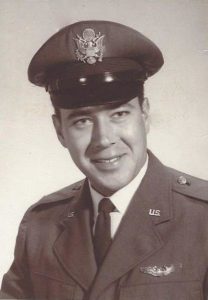
15 March 1967 – “Vic Thompson III graduated from Sam Houston High School where he was Cadet Colonel in the ROTC. His senior yearbook shows he was selected “Cadet of the Year”.
[Note: Vic’s father, Victor Hugo Thompson Jr., played a large role in his son’s life. Brig. Gen. Thompson had enrolled at A&M in 1939 but Pearl Harbor interrupted his junior year and he was off to Aviation Cadet training. At the end of WWII, Gen. Thompson retained his reserve commission. He retired from the USAF Reserves in 1981.]
As for Vic Jr., on Jan. 19, 1965, Gen. Earl Rudder presented the diploma to Vic certifying him as a Bachelor of Arts in English. Later that day, Vic was commissioned as a Second Lieutenant in the United States Air Force. Vic and his wife Charlotte packed up their belongings and headed to Laredo Air Force Base where Vic reported for Undergraduate Pilot Training in UPT Class 66G.
His performance in UPT made him a “hot commodity” and caused a lot of angst when the time came to decide what Vic’s next move would be. Vic could not have been happier. His aircraft assignment would be F-100s – The Super Sabre! With his new Pilot’s Wings pinned on, once again Vic and Charlotte loaded their belongings. This time they pointed the car to the west, toward Phoenix, Arizona, and Luke AFB for 2-3 months of transition training in the F-100. He completed his training in December 1966. Vic then arrived in Vietnam on February 20, 1967.
 On March 15, 1967, Combat Mission 21 was a two-aircraft mission with Vic flying as Ramrod 2. The F-100’s carried a full complement of munitions for a ground attack mission – bombs, napalm, and 20 mm cannons. The 40-mile trip to the target area took less than ten minutes, but it is likely that Ramrod One and Two loitered in a holding pattern over the South China Sea for a few minutes while they checked-in with the Forward Air Controller (FAC) in an L-19 Bird Dog.
On March 15, 1967, Combat Mission 21 was a two-aircraft mission with Vic flying as Ramrod 2. The F-100’s carried a full complement of munitions for a ground attack mission – bombs, napalm, and 20 mm cannons. The 40-mile trip to the target area took less than ten minutes, but it is likely that Ramrod One and Two loitered in a holding pattern over the South China Sea for a few minutes while they checked-in with the Forward Air Controller (FAC) in an L-19 Bird Dog.
When the time came, the two F-100s turned out of the loiter pattern and approached the target at enough altitude – three or four thousand feet – to avoid detection. Without notice, the FAC turned his L-19 toward the target and fired a single rocket to mark the target. Ramrod One immediately banked his F-100 and dove toward the target to launch his first bomb. Ramrod Two (Vic) followed closely with his first “iron bomb.” Ramrod was on target again.
The air defense system used by the VC in 1967 was very simple. When our aircraft were overhead, they fired their AK-47s or 12.75 mm machine guns in the air and hoped the American airplane flew into the stream of bullets. Ramrod One and Two made another bomb pass and two napalm passes without response from the defenders.
Ramrod One completed his fifth pass using his 20mm cannon, and Vic followed for his first cannon run. Just before he could pull out of the dive, Vic’s aircraft was hit by ground-fire and plunged directly into the ground 300m from the target. No parachute was seen. The location of the wreckage and the intensity of the ground-fire prevented any rescue or recovery. Ramrod One returned to Bien Hoa to report Vic as Missing/Presumed Killed in Action (KIA).
The area around Vic’s crash site would remain in enemy hands until the war was over. During that time, Vic was officially carried as Missing and Presumed Dead.
Almost six years later, on Jan. 3, 1973, President Richard Nixon formally announced measures that would bring peace to Vietnam. That same year, the remains of 1st Lt. Victor Hugo Thompson III were recovered. A year later they were identified and bought home to Texas to be buried with full military honors.”
Source: Much of this information came from an article of the Texas A&M Aggie Network. https://www.aggienetwork.com/media/guides/class%20resources/classes%201960-1969/class%20of%201964/class%20of%201964%20classmate%20tributes/vic%20thompson%20article.pdf
